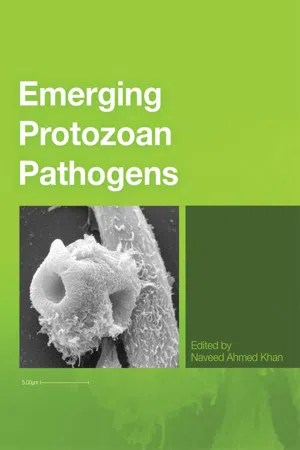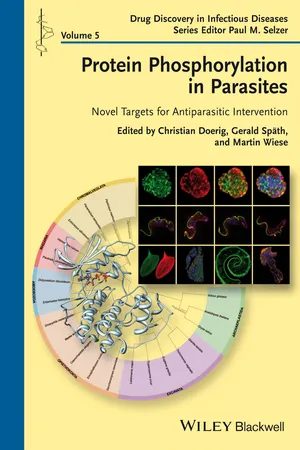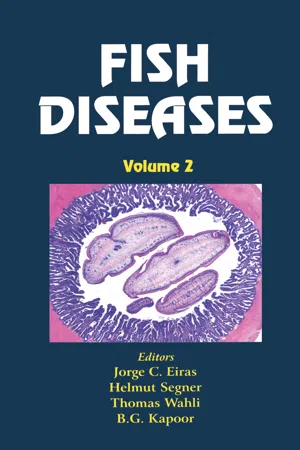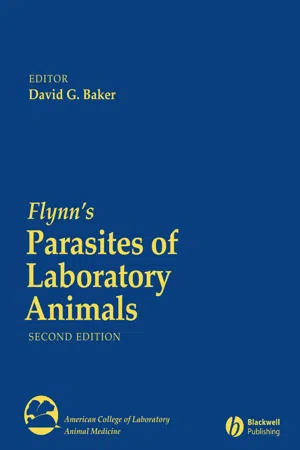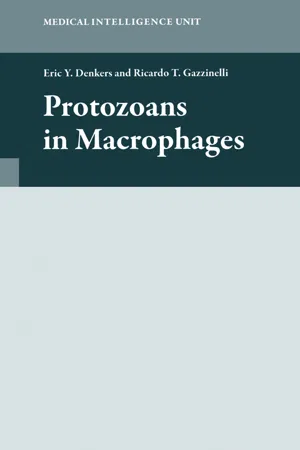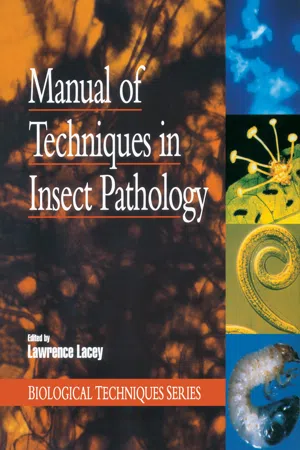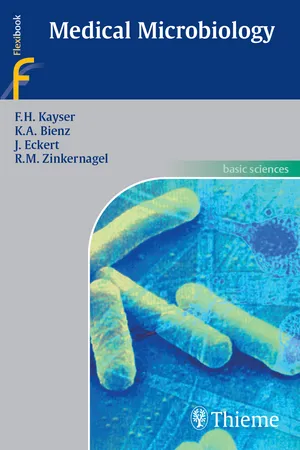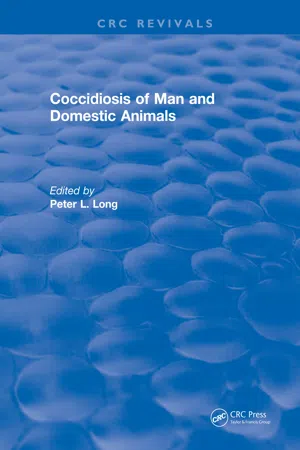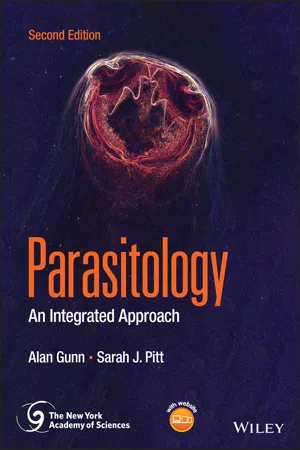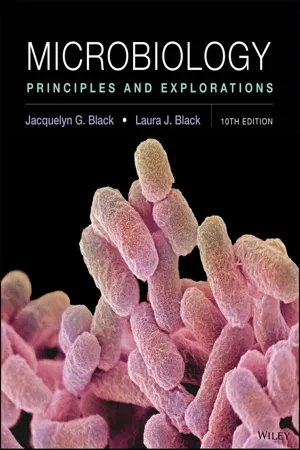Biological Sciences
Apicomplexans
Apicomplexans are a group of single-celled parasites known for causing diseases in animals, including humans. They possess a unique organelle called the apicoplast, which is essential for their survival and has become a target for drug development. Apicomplexans include the causative agents of diseases such as malaria (Plasmodium spp.) and toxoplasmosis (Toxoplasma gondii).
Written by Perlego with AI-assistance
Related key terms
1 of 5
10 Key excerpts on "Apicomplexans"
- eBook - ePub
- Naveed Ahmed Khan(Author)
- 2008(Publication Date)
- Taylor & Francis(Publisher)
Toxoplasma). Some Apicomplexans are blood parasites, while others infect the digestive system or various organs. The most diverse group is represented by the gregarines, which are restricted to invertebrate hosts.Figure 2 Artistic rendering of a Cryptosporidium sporozoite with various organelles depicted. The apical complex is comprised of the conoid, micronemes, rhoptry and dense granules.To provide a context for understanding the apicomplexan clade, several important genera are worth mentioning. Of the Apicomplexa, malaria parasites (Plasmodium spp. within the class Haemosporida) are worldrenowned and malaria (as a disease) has been known since ancient times. Other well-known blood parasite species lie within the genera Theileria and Babesia (class Piroplasmida). These bloodborne species require arthropod vectors for dissemination and to complete their life cycles. In addition to cryptosporidial species, intestinal parasites of humans and animals include members of the Cyclospora and Isospora genera and many different Eimeria species (Emeriidae) may infect and cause economic losses in farmed chickens and other animals. Members of the genera Neospora and Sarcocystis (Sarcosystidae) are known to induce birth defects or abortion in domesticated animals. While Toxoplasma gondii (Sarcosystidae) can cause similar teratogenicity in humans and domesticated animals, it is also capable of causing encephalitis in immunocompromised individuals. In short, these examples embody the point that all members of the Apicomplexa are parasitic, and many are of great medical or veterinary importance.The classification of Apicomplexans has been the subject of a number of debates. A classification is presented in Figure 3, but this representation may not reflect the opinions of various experts within the scientific community. Recent molecular evidence indicates that the evolutionary relationships among the Apicomplexa may be significantly different from their taxonomic classification. Cryptosporidium, for example, may have a closer relationship to the gregarines, rather than to other eimeriid coccidia (Barta and Thompson, 2006). It is generally not debated that Cryptosporidium species are eukaryotes (protozoa, alveolates) within the phylum Apicomplexa. However, classification schemes within the Apicomplexa continue to invoke substantial scrutiny. Despite intensive efforts, a recent authoritative text on the classification of the protozoa indicates that subdivisions that include Cryptosporidium and related species are artificial, not monophyletic, and presently unresolved (Adl et al. - eBook - ePub
Protein Phosphorylation in Parasites
Novel Targets for Antiparasitic Intervention
- Christian Doerig, Gerald Spaeth, Martin Wiese, Christian Doerig, Gerald Spaeth, Martin Wiese, Paul M. Selzer(Authors)
- 2013(Publication Date)
- Wiley-Blackwell(Publisher)
Part One Bioinformatics 1 Computational Analysis of Apicomplexan Kinomes Eric Talevich, Natarajan Kannan, and Diego Miranda-Saavedra * Abstract Apicomplexan parasites are responsible for a large number of diseases affecting much of the World's population, and as a result place a tremendous burden on the economic development of many countries. Protein kinases, a large family of enzymes regulating almost every known cellular process, have emerged as potential key drug targets for antiparasitic therapies. In this chapter we review recent bioinformatic investigations aimed at identifying the most promising protein kinase drug targets. An overview of the resources available for the study of apicomplexan genomes is first provided, especially databases of protein kinases and custom methods for the sequence analysis of kinases, as well as some practical guidelines for the annotation of protozoan kinomes. Finally, recent findings on apicomplexan kinomes obtained from comparative studies of multiple species are summarized, and an explanation is provided as to how heterogeneous datasets (functional genetic, expression, phylogenetic and structural data) are integrated not only to identify the most important protein kinase drug targets but also to find their Achilles' heels in order to achieve their selective targeting. Introduction The Apicomplexa – derived from the Latin - apex (top) and complexus (composed of parts) – is a diverse phylum of unicellular parasitic protozoa named after a characteristic cellular structure (the apical complex) that is used to invade animal host cells. The apical complex is itself a set of unique organelles (the conoid, rhoptries, micronemes and polar or apical rings). Most Apicomplexans also contain apicoplasts, a unique nonphotosynthetic plastid, which was acquired ancestrally through the secondary endosymbiosis of a red alga [1] - eBook - PDF
- Jorge Eiras, Jorge Eiras, Helmut Segner, Thomas Wahli(Authors)
- 2008(Publication Date)
- CRC Press(Publisher)
Invertebrates, as well as acting as vectors for malaria parasites and other disease-inducing Apicomplexans of vertebrates, are themselves hosts to coccidian and gregarine parasites (Perkins et al., 2000). Apicomplexans are particularly ubiquitous in feral fish and often associated with disease under hatchery conditions. Piscine Apicomplexans exist in the form of intracellular parasites in cells of the intestine, swimbladder, liver, spleen, testes, kidney or gills, as well as in blood cells such as erythrocytes, lymphocytes, and monocytes (Davies and Ball, 1993). Organelles of the apical complex allow the invasive stage of Apicomplexans, the zoite, the entry of a host cell. The process of cell entry is very rapid and can occur in a few seconds (Sam-Yellowe, 1996). In simple terms, the entry process begins with zoites attaching to the host cell by means of parasite molecules that recognize host surface receptors. Initial loose contact is usually followed by reorientation of the zoite so that apical complex, and especially the protruded conoid, finally lies in direct apposition with the host cell membrane, and firmly anchored by a tight junction. The tight junction between parasite and host cell moves to the posterior end of the zoite as it enters the cell, while the host cell membrane invaginates. Host cell entry is facilitated by discharge of the contents of rhoptries and micronemes, and finally, the zoite lies within the host cell enclosed by a parasitophorus vacuole membrane (Sam-Yellowe, 1996). Within the parasitophorus vacuole, the parasite discharges the contents of its electron dense granules and these—with other secretory products— modify the structure of the parasitophorus vacuole membrane so that it avoids fusion with lysosomes and its contents remain at neutral pH (Cesbron-Delauw, 1994). - eBook - PDF
- David G. Baker(Author)
- 2008(Publication Date)
- Wiley-Blackwell(Publisher)
COCCIDIA AND COCCIDIA-LIKE PARASITES: PHYLUM APICOMPLEXA Apicomplexan parasites include the coccidia, malaria and malaria-like parasites, and piroplasms of vertebrates. Fig. 2.7 Trophozoite of Entamoeba histolytica. An ingested red blood cell (arrow) is labeled. Iron-hematoxylin stain of human feces. Laboratory animals are important models for human infections caused by these parasites. Some apicomplexa have direct or two-host life cycles and are transmitted by the fecal-oral route, whereas others are transmitted by arthropod vectors. Coccidian parasites with direct life cycles ( Cystoisospora spp.) can be a chronic problem in kennels and catteries because they are transmitted by environmentally resistant oocyst stages and are difficult to eradicate. The tissue cyst forming coccidia that have two-host life cycles ( Toxoplasma gondii, Neospora caninum, Sarcocystis spp., Besnoitia spp.) are not problems in modern animal facilities. Malaria and malaria-like blood parasites ( Plasmodium, Haemoproteus, Leucozytozoon ), and piroplasms ( Babesia, Theileria ) are rarely found in laboratory animal facilities because they require arthropod vectors to complete their life cycles. However, these parasites may be present in wild-caught animals brought into animal facilities. Wild-caught animals should be routinely examined for blood parasites as part of the quar-antine program. Blood-borne apicomplexa may be found in zoos where animals are exposed to arthropod vectors. Special Organelles Motile stages of coccidian parasites possess an assemblage of organelles which form the apical complex. These include the polar rings, rhoptries, micronemes, dense granules, conoid, and subpellicular microtubules 20 (Figure 2.3). The apical complex is used for host cell penetration. Rhoptries, micronemes, and dense granules contain complex mixtures of proteins that, upon exocytosis, interact with host cell membranes during host cell invasion 21 . - eBook - PDF
- Eric Denkers, Ricardo T. Gazzinelli(Authors)
- 2007(Publication Date)
- CRC Press(Publisher)
Acknowledgements I am grateful to members of my laboratory for many helpful discussions and for their con tributions to the work cited here and to many colleagues who have provided critical advice and reagents. Supported by the National Institutes of Health. References 1. Levine ND. The Protozoan Phylum Apicomplexa. Vols. 1,2. Boca Raton: CRC Press, 1988. 2. Morrissette NS, Sibley LD. Cytoskeleton of apicomplexan parasites. Microbiol Mol Biol Rev 2002; 66:21-38. 3. Baldauf SL, Roger AJ, Wenk-Siefert I et al. A kingdom-level phylogeny of eukaryotes based on combined protein data. Science 2000; 290:972-977. 4. Roos DS, Donald RGK, Morrissette NS et al. Molecular tools for genetic dissection of the proto zoan parasite Toxoplasma gondii. Methods Cell Biol 1994; 45:28-61. 5. Dubey JP, Beattie CP. Toxoplasmosis of animals and man. Boca Raton: CRC Press, 1988. Invasion and Intracellular Survival by Toxoplasma 23 6. Channon JY, Seguin RM, Kasper LH. Differential irifectivity and division of Toxoplasma gondii in human peripheral blood leukocytes. Infect Immun 2000; 68:4822-4826. 7. Wilson CB, Tsai V, Remington JS. Failure to trigger the oxidative burst of normal macrophages. J Exp Med 1980; 151:328-346. 8. Jones TC, Hirsch JG. The interaction of Toxoplasma gondii and mammalian cells. II The absence of lysosomal fusion with phagocytic vacuoles containing living parasites. J Exp Med 1972; 136:1173-1194. 9. Jones TC, Yeh S, Hirsch JG. The interaction between Toxoplasma gondii and mammalian cells. I. Mechanism of entry and intracellular fate of the parasite. J Exp Med 1972; 136:1157-1172. 10. Sibley LD, Weidner E, Krahenbuhl JL. Phagosome acidification blocked by intracellular Toxo plasma gondii. Nature 1985; 315:416-419. 11. Mordue DG, Sibley LD. Intracellular fate of vacuoles containing Toxoplasma gondii is determined at the time of formation and depends on the mechanism of entry. J Immunol 1997; 159:4452-4459. 12. Petersen E, Dubey JP. - eBook - PDF
- Lawrence A. Lacey(Author)
- 1997(Publication Date)
- Academic Press(Publisher)
Apicomplexa, are intracellular or/and epi- cellular, and usually infect gut tissues, Malpighian tubules and fat bodies, but also have forms occupy- ing the haemocoel. Microsporidia are strictly intra- cellular and their representatives can be found in any type of host tissues. The few ciliates that occur in insects appear to be restricted to the hemocoel. The protozoa-insects symbiotic relationships vary from those in which both partners are indifferent to each other, the insect simply providing the spatial niche for the protozoan (commensalism), to those in which the protozoa living inside the insect host are essential for its survival (mutualistic relationship) or in which the protozoan is truly pathogenic to the insect host (parasitism). The focus here will be on those groups that are pathogenic to their hosts, pro- viding only basic data necessary for the identifica- tion of non-pathogenic taxa. Blood-sucking insects serve as vectors of many protozoa, especially the fla- gellates (trypanosomes and their relatives) and Apicomplexa (Plasmodium and other blood para- sites). Although extremely important from medical and veterinary aspects, these pathogens of man and 118 Albert H. Undeen & Ji~f V~ivra animals are beyond the scope of this chapter and will be mentioned only briefly. 2 IDENTIFICATION This section provides a brief account of the Protozoa that are commonly found in insects and the insects in which they occur. Additional sources, such as Jahn's brief, but very informative booklet How to know Protozoa, Kudo's Protozoology (Kudo, 1966), Weiser's Atlas of insect diseases (1977), Laboratory guide to insect pathogens and parasites (Poinar & Thomas, 1984), An illustrated guide to the protozoa (Lee et al., 1985), Biological control of vectors (Weiser, 1991) and Insect pathology by Tanada & Kaya (1993) need to be sought for further informa- tion. - eBook - PDF
- F. H. Kayser, K. A. Bienz, J. Eckert(Authors)
- 2011(Publication Date)
- Thieme(Publisher)
V Parasitology Trichinella spiralis 9 Protozoa J. Eckert General information on parasites. A parasite (from the Greek word parasitos ) is defined as an organism that lives in a more or less close association with another organism of a different species (the host), derives sustenance from it and is pathogenic to the host, although this potential is not always expressed. In the wider sense, the term parasite refers to all organisms with such char-acteristics. In medicine the term is used in a narrower sense and designates eukaryotic pathogens, which belong to the protozoa (unicellular organisms Chapter 9) and metazoa, including helminths (parasitic “worms,” Chapter 10), arthropods (Chapter 11), and some other groups of lower medical signifi-cance (Annelida, Pentastomida, not covered in this book). Parasites cause numerous diseases (parasitoses) in humans, some being of extraordinary significance (e.g., malaria). Of practical concern in central Europe are both autochthonous and imported (tropical and travelers’) parasitic infections. A uniform disease nomenclature has been adopted in this book with the sole use of the suffix – osis (plural – oses )—for example trypanosomosis and not trypanosomiasis. This system, based on the Standardized Nomenclature of Parasitic Diseases (SNOPAD) (originally published in 1988 and recom-mended by the International Society of Parasitologists) avoids the inconsis-tent usage of disease names, such as leishmaniasis on the one hand and toxoplasmosis on the other. A selection of the most important parasitoses is presented in the following chapters. In Table 1. 10 (p. 28) zoonoses caused by parasites are listed. Parasitic protozoa are eukaryotic, single-celled microorganisms about 1–150 l m in size and enclosed by a trilaminated cell membrane. They possess one, rarely two nuclei (and multinuclear reproductive forms). Reproduction is asexual by binary or multiple fission of the cell, or sexual. - eBook - ePub
- Peter L. Long(Author)
- 2019(Publication Date)
- CRC Press(Publisher)
C. parvum may also be an under-reported cause of respiratory and biliary tract disease, especially in the immune deficient host.5III Taxonomy
As a direct result of the rapid advances in our understanding of the fine structure of parasitic protozoa that occurred in the early 1960s,13 ,14 the phylum Apicomplexa Levine 1970 was established in an attempt to make some sense of the “Sporozoa” that contained diverse groups of protozoan parasites.24 The phylum Apicomplexa brings together all protozoa that possess an apical complex, an assemblage of organelles at the anterior end of certain life cycle stages that facilitate attachment to or entry into host cells. These organelles (Figure 1 ) include: one or more electron dense polar rings; a conoid formed by several spirally coiled microtubules inside the polar ring; a number of rhoptries (toxonemes, paired organelles, lankesterellonemes, eimerianemes, dense bodies) — electron dense, tubular, or saccular organelles, often enlarged posteriorly, extending back from the anterior region inside the conoid; a number of micronemes (sarconemes, convoluted tubules, rod-shaped granules) — elongate, electron-dense organelles extending longitudinally in the anterior part of the cell, perhaps attached to the rhoptries; and a number of subpellicular microtubules (subpellicular microfibrils) — slender, electron-dense hollow structures extending back just beneath the pellicle from a polar ring. Thus, the Apicomplexa as we know it today includes not only the true coccidia (suborder Eimeriorina) but also the malarial parasites (suborder Haemosporina) of man and other animals, the piroplasms of domesticated and wild animals, the heteroxenous hemogregarines, and the gregarines of invertebrates. A more thorough treatment of the taxonomy and biology of the more than 4000 named species and over 300 named genera in the Apicomplexa can be found in books dealing with the protozoa24 or more specifically with the phylum itself.25 A more recent phylogenetic analysis of the apicomplexan class Sporozoea (Sporozoasida)26 suggests that previous treatments24 ,25 - eBook - ePub
Parasitology
An Integrated Approach
- Alan Gunn, Sarah J. Pitt(Authors)
- 2022(Publication Date)
- Wiley(Publisher)
3 Parasitic Protozoa Part A: Phyla Rhizopoda, Metamonada, ApicomplexaCONTENTS
- 3.1 Introduction
- 3.2 Phylum Rhizopoda
- 3.2.1 Entamoeba histolytica
- 3.2.2 Entamoeba dispar
- 3.2.3 Entamoeba moshkovskii
- 3.2.4 Entamoeba gingivalis
- 3.2.5 Naegleria fowleri
- 3.2.6 Balamuthia mandrillaris
- 3.2.7 Genus Acanthamoeba
- 3.3 Phylum Metamonada
- 3.3.1 Order Diplomonadida
- 3.3.2 Order Trichomonadida
- 3.4 Phylum Apicomplexa
- 3.4.1 Genus Plasmodium
- 3.4.2 Genus Theileria
- 3.4.3 Genus Babesia
- 3.5 Subclass Coccidiasina
- 3.5.1 Genus Eimeria
- 3.5.2 Genus Isospora
- 3.5.3 Genus Cystoisospora
- 3.5.4 Genus Cyclospora
- 3.5.5 Genus Sarcocystis
- 3.5.6 Genus Toxoplasma, Toxoplasma gondii
- 3.5.7 Genus Neospora
- 3.5.8 Genus Cryptosporidium
3.1 Introduction
For many years, the protozoa were placed within the Kingdom Animalia, but they now represent a subkingdom within the Kingdom Protista. That is, the protists (single celled eukaryotes) now having a separate kingdom of their own. Thomas Cavalier‐Smith and his co‐workers have proposed even more radical re‐arrangements (Ruggiero et al. 2015 ). They suggest that several phyla that have always been considered protozoa should be moved to form a further new Kingdom, the Chromista. This would include the Apicomplexans, the ciliates, dinoflagellates, and the foraminifera (Cavalier‐Smith 2018 ). We are not adopting their proposals because they are not yet widely accepted but this may change.In this and the next chapter, we summarise the life cycles and biology of some of the most important parasitic protozoa in human and veterinary medicine. Although they consist of just a single cell, parasitic protozoa come in numerous shapes and sizes. Many of them have complicated life cycles involving two or more taxonomically unrelated hosts with reproduction occurring in both. These complexities often contribute to their success as parasites. They exhibit a vast array of immune‐avoidance mechanisms, and their pathology is often influenced by their interactions with other microorganisms. Parasitic protozoa live in all the organs of our body and cause diseases ranging from benign to rapidly and incurably fatal. They also exhibit every imaginable means of infecting their hosts from simple contamination to sexual and vector‐assisted transmission. - eBook - PDF
Microbiology
Principles and Explorations
- Jacquelyn G. Black, Laura J. Black(Authors)
- 2018(Publication Date)
- Wiley(Publisher)
Zygotes pass through the stomach wall and produce sporozoites, which eventually make their way to the salivary glands. Several species of Plasmodium cause malaria, and each displays variations in the life cycle just described and in the particular species of mosquito that serves as a suitable host. Another apicomplexan, Toxoplasma gondii, causes lymphatic infections and blindness in adults and severe neurological damage to the fetuses of infected pregnant women. It has also recently been implicated as a possible cause of schizophrenia. Contact with infected domestic cats and their feces, consumption of contami- nated raw meat, and failure to wash one’s hands after handling such meat are means of transmitting the para- site. See Chapter 24 for a discussion of the T. gondii life cycle and more information. Ciliates. The largest group of protozoans, the ciliates, have cilia over most of their surfaces. Cilia have a basal body near their origin that anchors them in the cytoplasm and enables them to extend from the surface of the cell. Cilia allow the organisms to move, and in some genera, such as Paramecium (Figure 12.7), cilia assist in food gath- ering. Balantidium coli, the only ciliate that parasitizes humans, causes dysentery. Ciliates have several highly specialized structures. Most ciliates have a well-developed contractile vacuole, which regulates cell fluids. Some have a strengthened pellicle. Others have trichocysts, tentacles that can be FIGURE 12.7 Paramecium caudatum (171X), a ciliate. (blickwinkel/Alamy Stock Photo) FUNGI Characteristics of Fungi Fungi, studied in the specialized field of mycology, are a diverse group of heterotrophs. Many are saprophytes that digest dead organic matter and organic wastes. Some are parasites that obtain nutrients from the tissues of other organisms. Most fungi, such as molds and mushrooms, are multicellular, but yeasts are unicellular.
Index pages curate the most relevant extracts from our library of academic textbooks. They’ve been created using an in-house natural language model (NLM), each adding context and meaning to key research topics.
